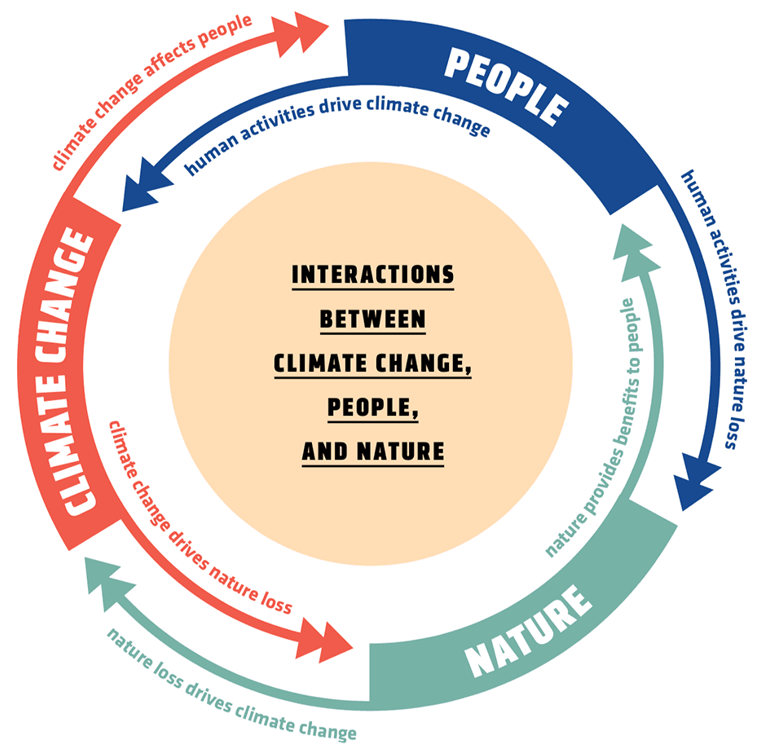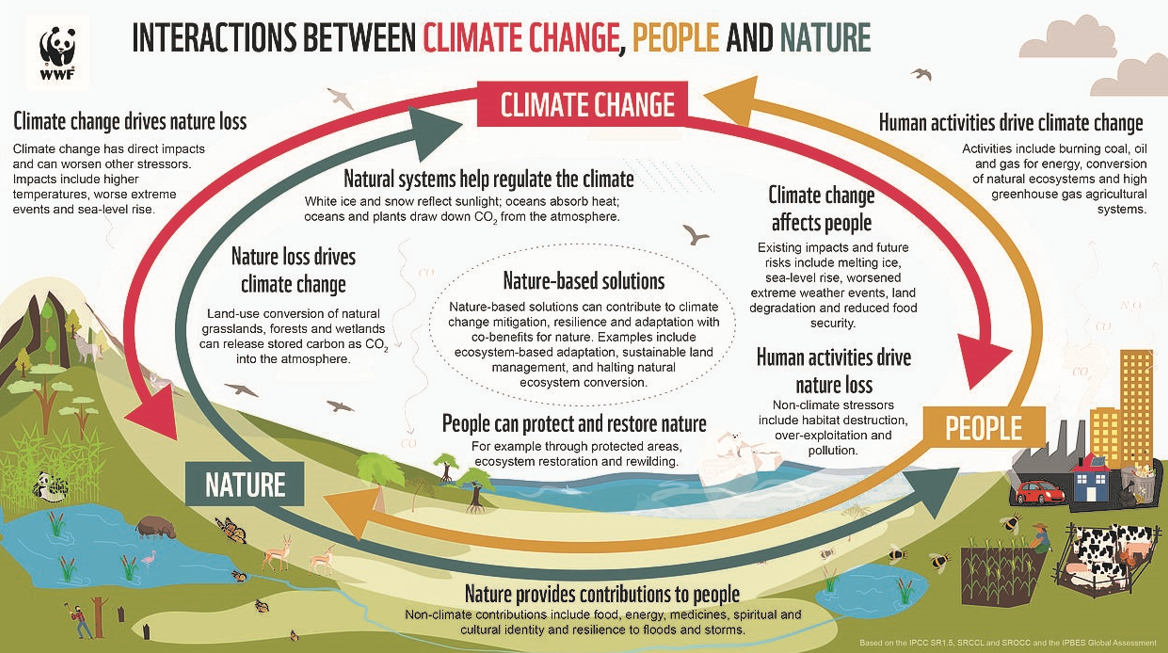
The challenges facing people, nature, and climate are deeply intertwined, and lasting solutions must address these issues collectively. WRI is committed to an integrated approach that seeks meaningful, long-term impact by advancing three core goals:
1. Ensuring people live in an equitable society where basic needs are met.
2. Protecting and restoring natural ecosystems.
3. Stabilizing the climate and fostering resilient communities.
We believe that by tackling these goals together, we can create synergies and lasting positive change that benefit everyone.
Interaction Between Climate Change, Nature, and People
The connections between climate change, nature, and people are intricate and far-reaching, each influencing the others in profound ways. Below is a comprehensive look at these interactions:
1. People’s Impact on Nature and Climate
- Deforestation and Land Use Change: Human activities such as deforestation, urbanization, and agriculture lead to habitat destruction, reduced biodiversity, and increased carbon emissions.
- Pollution: Industrial and agricultural practices release pollutants into the environment, affecting ecosystems and contributing to climate change.
- Resource Exploitation: Activities like overfishing, mining, and excessive resource extraction deplete natural resources and disrupt ecosystems.
2. Climate Change Impacts on Nature
- Extreme Weather Events: More frequent and severe weather events—such as hurricanes, droughts, and wildfires—devastate ecosystems, causing long-term ecological shifts.
- Ocean Acidification: Rising CO2 levels increase ocean acidity, threatening marine life, especially species with calcium carbonate structures, like corals and mollusks.
- Habitat Loss and Alteration: Changing temperature and precipitation patterns force species to migrate, leading to habitat loss and a decline in biodiversity.
3. Climate Change Impacts on People
- Health Risks: Higher temperatures and erratic weather can result in heat stress, respiratory issues, and the spread of diseases. Extreme weather events also contribute to injuries, fatalities, and mental health issues.
- Food and Water Security: Climate change impacts agricultural yields, causing food shortages and higher prices. Water availability is also affected, with some areas facing severe droughts while others experience flooding.
- Economic Disruption: Industries reliant on natural resources—such as agriculture, fisheries, and tourism—are particularly vulnerable to climate change, which can disrupt economies and livelihoods.
4. Nature’s Role in Climate Regulation
- Climate Regulation: Ecosystems like forests and oceans are essential for regulating the Earth’s climate. Forests, for instance, influence local weather and global carbon cycles.
- Carbon Sequestration: Natural landscapes such as forests, grasslands, and wetlands play a crucial role in absorbing CO2 from the atmosphere, mitigating climate change. Protecting and restoring these ecosystems enhances their carbon storage capacity.
5. Nature-Based Solutions (NbS) for Climate and People
- Ecosystem Restoration: Restoring damaged ecosystems—such as reforesting and rehabilitating wetlands—can boost biodiversity, improve ecosystem services, and sequester carbon.
- Sustainable Agriculture: Practices like agroforestry, permaculture, and regenerative agriculture improve soil health, increase biodiversity, and reduce greenhouse gas emissions.
- Urban Green Infrastructure: Incorporating green spaces, green roofs, and urban forests in cities can mitigate the urban heat island effect, improve air quality, and enhance residents’ health and well-being.
6. Community and Policy Integration
- Community Involvement: Engaging local communities in conservation and climate action ensures that solutions are culturally relevant and benefit from local expertise and knowledge.
- Policy Frameworks: Effective climate policies should integrate nature-based solutions, encourage sustainable practices, and ensure that benefits are equitably shared across communities.
The interconnectedness of climate change, nature, and people demands a holistic approach to addressing the climate crisis. By incorporating nature-based solutions, we can restore ecosystems, mitigate climate impacts, enhance biodiversity, and provide essential services to human communities. This integrated approach ensures that our climate actions benefit both nature and people, creating a resilient and sustainable future for all.

